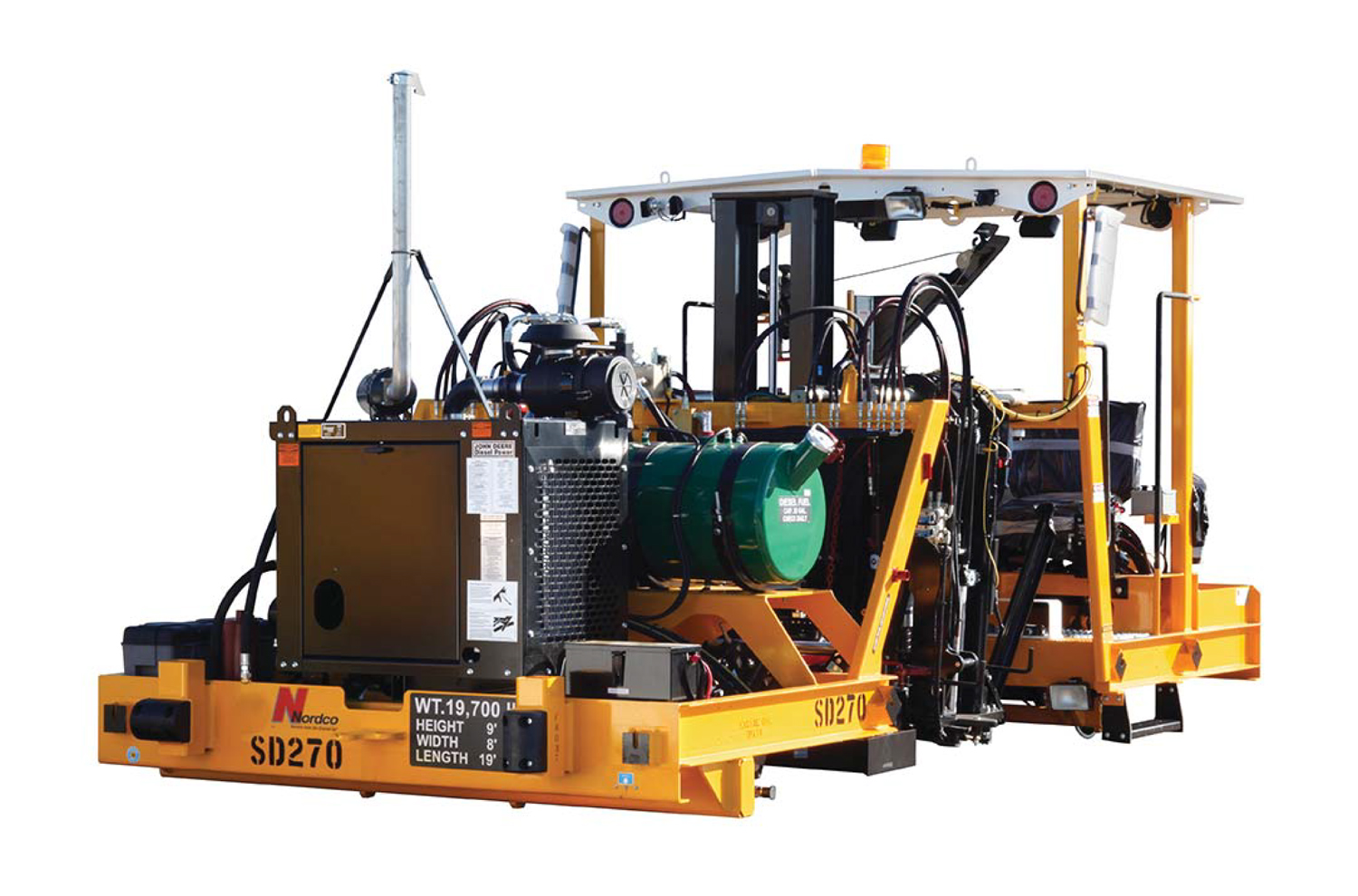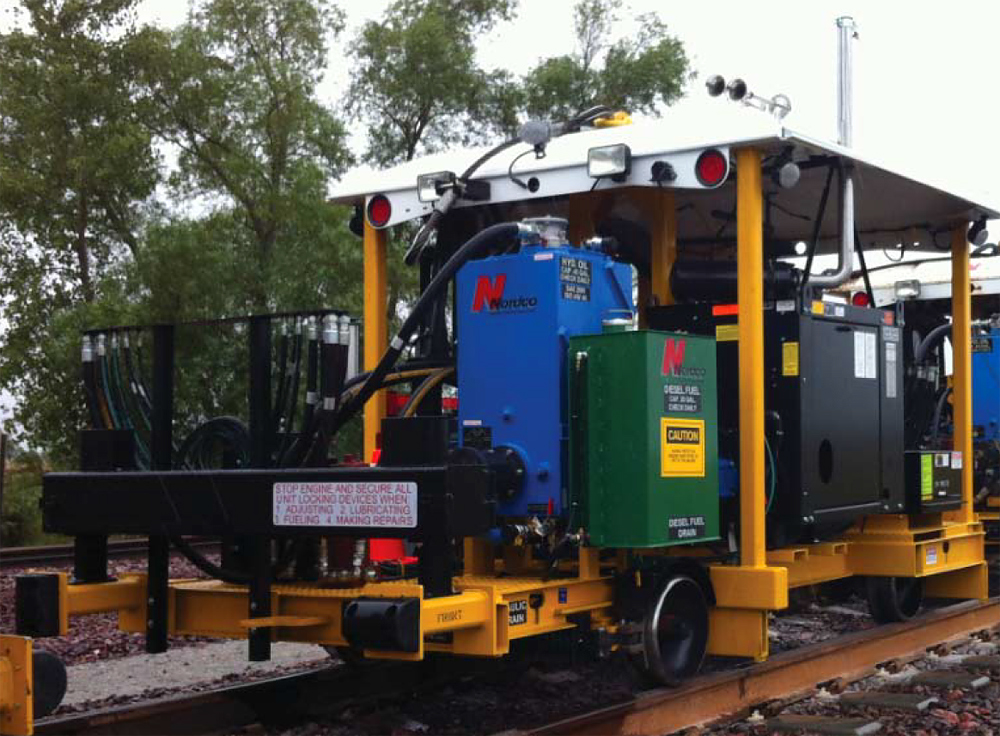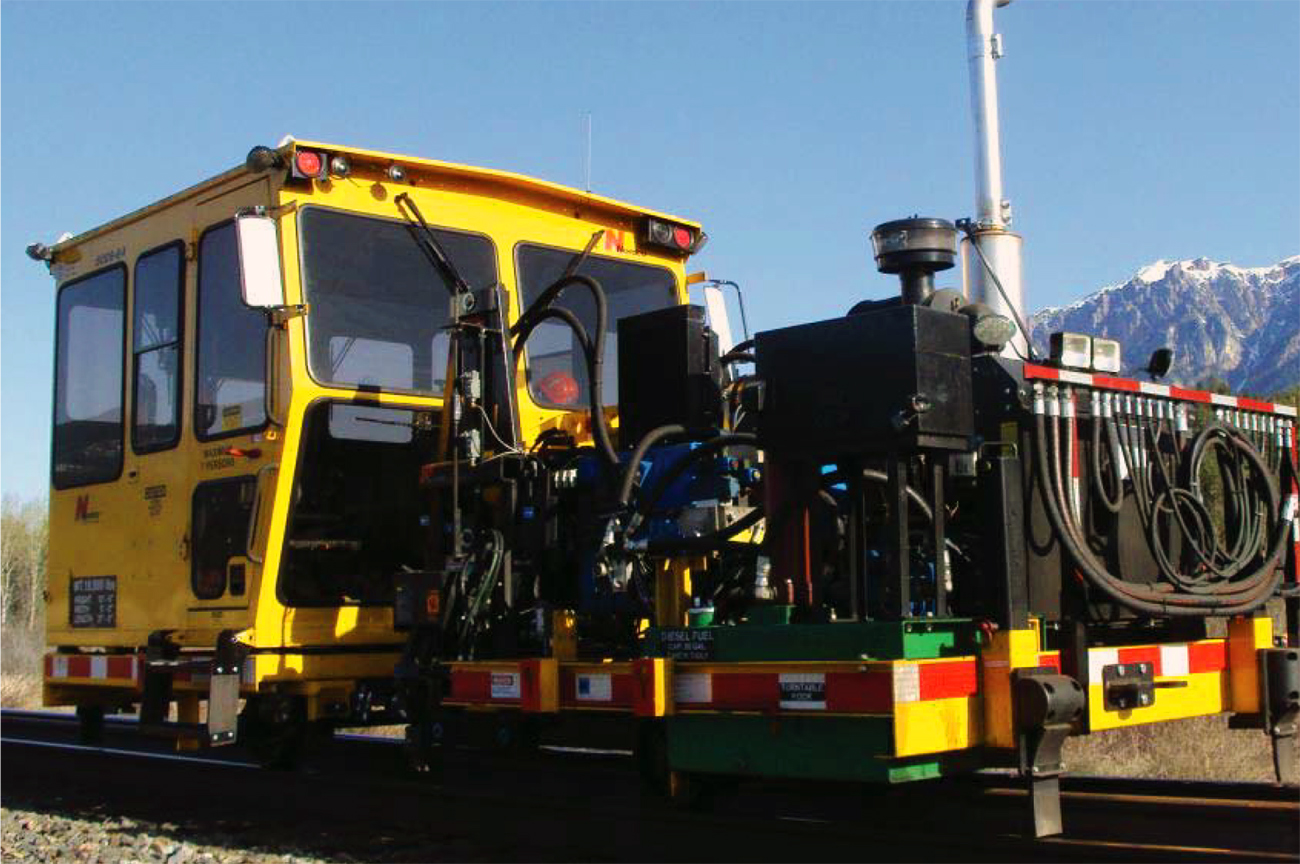Railroad Spike Inserters/Pullers: Mechanizing Rail Maintenance
Last revised: September 4, 2024
By: Adam Burns
Spike inserters may look complicated from the outside with a
host of equipment and gadgets to see but their function is rather
straightforward, as the name implies.
The machines, sometimes known as spike drivers, are amazingly efficient capable of inserting spikes into plates at a rapid pace, much more quickly than via manual labor which was the preferred method for years (that obviously required a strong back and powerful arms).
There are several different spike inserters models (also known as spike drivers) out there and in use today with most manufactured by Harsco Rail one of the leading companies in the field.
However, some of the most common are operated by three workers whereby one person feeds the spikes and the other two apply the spikes into the tie (one on each side of the rail).
Railroad spike inserters almost always work as some kind of mechanized gang, usually as part of a tie gang (which today normally consists of an army of machines, not men).
Today's tie gangs includes such machines as:
- Spike or rail anchor pullers (which pull the spikes/anchors clear of the tie)
- Tie cranes (which remove the railroad ties once they are free of the rails)
- Tie extractors/inserters (different from a tie crane these machines work vertically to remove or replace the railroad tie from underneath the rail)
- Spike inserters (as you might have guessed these machines use hydraulics to quickly drive spikes down in the tie plate and tie itself)
If very heavy work is being done other large equipment will be used such as a mechanized tie relaying machine and/or even a rail train if new rail is to be laid. As it is, tie gangs may look like machines simply heading off to work in an elephant line.
However, they are actually very coordinated work details with each machine and accompanying operator assigned a very specific task to get the work done as quickly as possible.
The reason for speed and hastiness in finishing a maintenance job is simply, to keep the trains and goods moving.
Delays are quite costly and avoided at all costs because if the freight isn't delivered the railroad's don't get paid! While the laborious task of driving spikes by hand is still done today, even on Class I railroads for minor maintenance work, for larger jobs to keep the trains rolling spike inserters are used.
The job is done very fast with the operator of the machine (who also pulls double-duty applying and driving the spikes, although today's newest models can be operated on one side or the other) aligning it over the tie and, along with his counterpart on the other side of the machine drives the spikes into each side of the rail.
If needed a third person is employed to make sure the tie inserter always has plenty of spikes. The simple reality is that these machines save railroads thousands of maintenance hours and hundreds of thousands of dollars in labor costs each year thanks to their efficient work.
No longer does the industry have to employ an army of workers to maintain its right-of-way. Being self-propelled, railroad tie inserters can clip along at a quick pace with a top speed of nearly 30 mph (although when inserting spikes the machine goes much slower, around 10 mph), completing a long stretch of main line in a day's time.
Today's models also are heavily computer-controlled and usually feature push-button or joystick controls.
There you can get an idea of what the machines look like and their exact specifications as well as learn about related equipment such as tie cranes, exchangers, undercutters, blowers, and a wide range of other equipment.
Spike Pullers
Its name being rather straightforward in describing what it does, railroad spike pullers have been around for several decades now and greatly ease the task of removing spikes during maintenance projects (whether it be to replace ties, rails, or both).
That is, of course, unless you are the one operating the machine as the work is hot in the summer, cold in the winter, noisy, and gives one a good jolt when pulling spikes.
Spike pullers have a rather unique, unconventional look but are usually easily recognizable by the fact that they have a low profile, open air design and usually only carry one operator.
The machine is similar to the inserter except, as the name implies it removes spikes and does so much more quickly than via manual labor. Today, the major builder of inserters and related equipment is Harsco Rail.
Spike pullers almost always work as some kind of mechanized gang, usually as part of a tie gang (which today normally consists of an army of machines, not men).
Today's tie gangs includes such machines as:
- Spike or rail anchor pullers (which pull the spikes/anchors clear of the tie)
- Tie cranes (which remove the railroad ties once they are free of the rails)
- Tie extractors/inserters (different from a tie crane these machines work vertically to remove or replace the railroad tie from underneath the rail)
- Spike inserters (as you might have guessed these machines use hydraulics to quickly drive spikes down in the tie plate and tie itself).
If very heavy work is being done other large equipment will be used such as a mechanized tie relaying machine and/or even a rail train if new rail is to be laid. As it is, tie gangs may look like machines simply heading off to work in an elephant line.
However, they are actually very coordinated work details with each machine and accompanying operator assigned a very specific task to get the work done as quickly as possible.
The reason for speed and hastiness in finishing a maintenance job is simply, to keep the trains and goods moving.
Delays are quite costly and avoided at all costs because if the freight isn't delivered the railroad's don't get paid! Spike pullers, like virtually all mechanized railroad maintenance equipment used today, use hydraulics to get the job done.
The machine itself is usually ten to twenty feet in length (although some models are very small) and in most cases uses one operator although newer models being built today feature two operators, which allow for the job to be done faster by spikes being pulled from each rail simultaneously.
Most railroad spike pullers built today feature a dull-head, hydraulic "jaw," which uses hydraulics to pull the spike from each side of the rail simultaneously.
These hydraulic jaws usually lie just behind or very near the cab of the operator so he or she can be right near the equipment to perform the work as efficiently as possible.
Older spike puller models required the operator to manually position the equipment over the rail and spike and properly align it to remove the latter.
Today's models are computer guided to greatly improve alignment, allowing the operator to move much more efficiently, and in affect gets the job done much faster. Time is money, and that phrase rings ever so true in the railroad industry.
When part of work detail you will usually see railroad spike pullers work in tandem, whereby the lead unit pulls spikes from one rail while another trails and removes spikes from the other.
However, as mentioned above with newer "dual" units which pull spikes from rails simultaneously and use two operators, these are becoming more widespread.
Recent Articles
-
Arizona - Wine Tasting - Train Rides
Dec 24, 25 10:53 AM
For those who want to experience the charm of Arizona's wine scene while embracing the romance of rail travel, wine tasting train rides offer a memorable journey through the state's picturesque landsc… -
Arkansas - Wine Tasting - Train Rides
Dec 24, 25 10:50 AM
This article takes you through the experience of wine tasting train rides in Arkansas, highlighting their offerings, routes, and the delightful blend of history, scenery, and flavor that makes them so… -
Wisconsin - Wine Tasting - Train Rides
Dec 24, 25 10:40 AM
Wisconsin might not be the first state that comes to mind when one thinks of wine, but this scenic region is increasingly gaining recognition for its unique offerings in viticulture.






